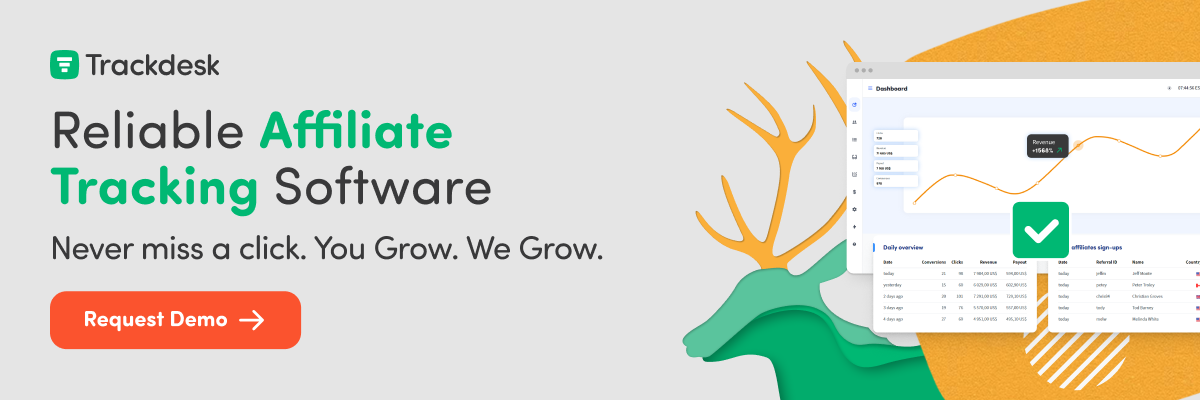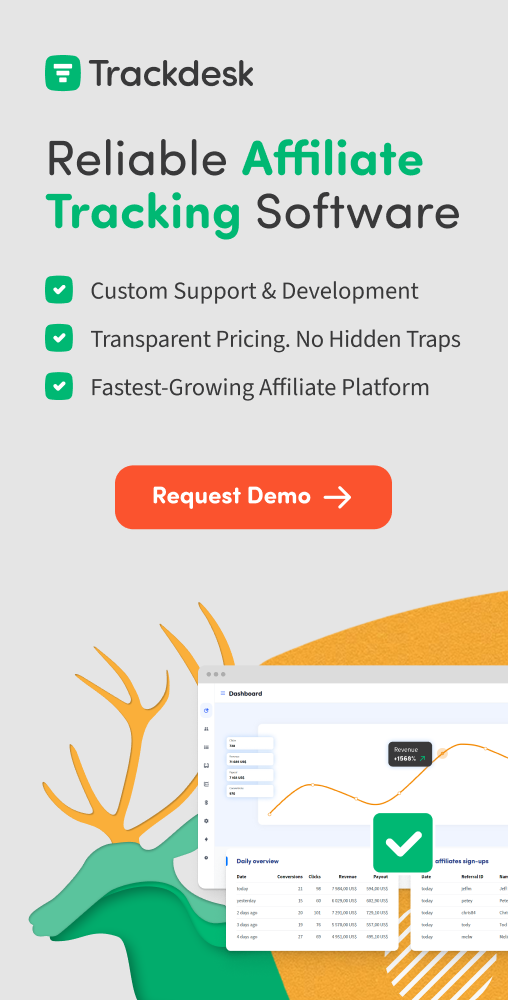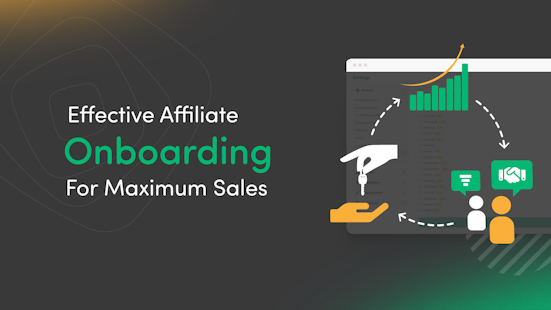
Affiliate Onboarding: How to Set Your Affiliates Up For Success
A good affiliate onboarding strategy will save you time and set up your affiliates to make the most sales possible — here’s what you need to know.
A good affiliate onboarding strategy should set your affiliates up to start making sales immediately.
But there’s more to it than that.
I’ve worked both with businesses onboarding affiliates and as an affiliate myself. I’ve seen both sides of the coin, and that gives me a unique perspective on how to get the most out of your affiliate program.
In today’s guide, I will teach you everything you need to know about affiliate onboarding so you can ensure your affiliate program is a huge success. Let’s dive in!
What is affiliate onboarding?
Affiliate onboarding is the process of introducing and integrating new affiliates into your affiliate marketing program. The goal is to get your affiliates (and therefore, you) to start earning money.
Your onboarding program can be as simple as sending them their affiliate link. That’s it, you’re done!
But if you want to maximize your revenue from your affiliates, it’s better to create a more in-depth onboarding process that includes a welcome kit, training, and additional resources.
Again — the more you invest in your affiliate relationships, the more money they will earn for you. So let’s talk about what makes a good affiliate onboarding program.
The 5 essentials of affiliate onboarding
A strong affiliate partnership requires more than just an affiliate link and a prayer.
Here are five things you should think about adding to your affiliate program to onboard new affiliates who are excited to promote your brand and your products:
1. Seamless affiliate tracking software
A good affiliate program starts with good affiliate tracking software.
Not only does good software make it easier to manage your affiliate partners, it also makes it easier for your affiliates to know how well they’re performing — and that’s a big deal.
As an affiliate myself, I’ve used a lot of different affiliate tracking software. One thing that always drove me crazy was when software had an ugly user interface (UI) that was awkward to manage. Poor reporting made it difficult to understand which of my links were performing well and discouraged me from investing more time and energy in promoting those partners.
On the flip side, software with a strong emphasis on usability and good reporting features made me excited to work with those partners and made it easier for me as an affiliate to know how to earn the most money possible.
In other words — good affiliate tracking software makes it easier to motivate your affiliates to make you more money and makes it easier for you to manage those affiliates and see your best performers.
Enter: Trackdesk.
https://www.youtube.com/watch?v=e-MstmY43ak
Trackdesk is a reliable affiliate tracking software that allows you to start, scale, and automate your affiliate program. It has a great UI on both the business side and the affiliate side and tracks all of the most important key performance indicators (KPIs) so both you and your affiliates understand how they’re performing.
2. Affiliate account manager
I’ve worked with dozens of companies as an affiliate, and the best companies had one thing in common…
An excellent affiliate account manager.
An account manager who understands your product and cares about the success of both your brand and your affiliates is an invaluable asset to exponentially grow your affiliate program’s revenue.
Not everyone will have the budget for this, but if you do, it’s something worth looking into.
Trackdesk has a Partnership Manager Marketplace where you can connect with over 500 qualified affiliate account managers for free as a perk of being a Trackdesk user.

3. Well-defined goals and structures
Start your affiliate program strong by defining clear goals—whether it's increasing sales, boosting brand visibility, or expanding reach. Each is a worthy goal, it just depends on where your business is at.
Next, identify who your ideal affiliates are. Some examples could be bloggers, influencers, niche experts, or even loyal customers. Ask yourself where these people go to find information online about your products or services. Read our article on how to find affiliates for more info.
Finally, design an attractive incentive structure that motivates affiliates while aligning with your goals, and establish straightforward guidelines to ensure everyone understands expectations. More on this later.
4. Comprehensive welcome kit
A welcome kit is exactly what it sounds like — a toolkit of resources to help new affiliates get started.
Trackdesk has a built-in welcome kit for new affiliates and brands to get started, showcasing each step to get started using the software:
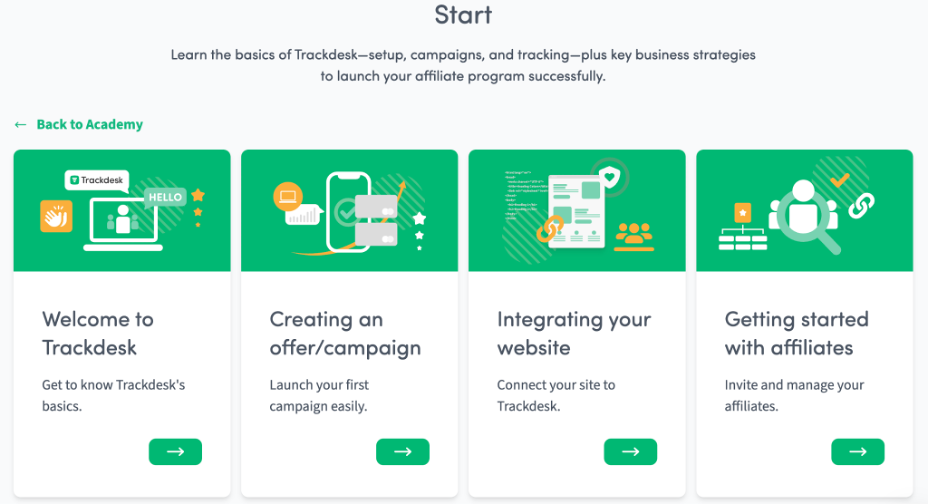
Your welcome kit should include an overview of your product/service, use-case scenarios, and a look into best strategies for promoting the product/service (if you know them). It should also include branding guidelines and any available media, like banner ads, images, or even a full media kit. To streamline the creation of promotional content, you can also include customizable banner templates and AI photo editors to create effective ads quickly.
5. Ongoing knowledge base/education
The most successful affiliate programs offer training resources to help their affiliates learn more about their products and understand the best ways to promote them.
For example, at Trackdesk we created our Affiliate Marketing Academy, which has guides to onboard new customers and teaches you everything you need to know to be successful with affiliate marketing.
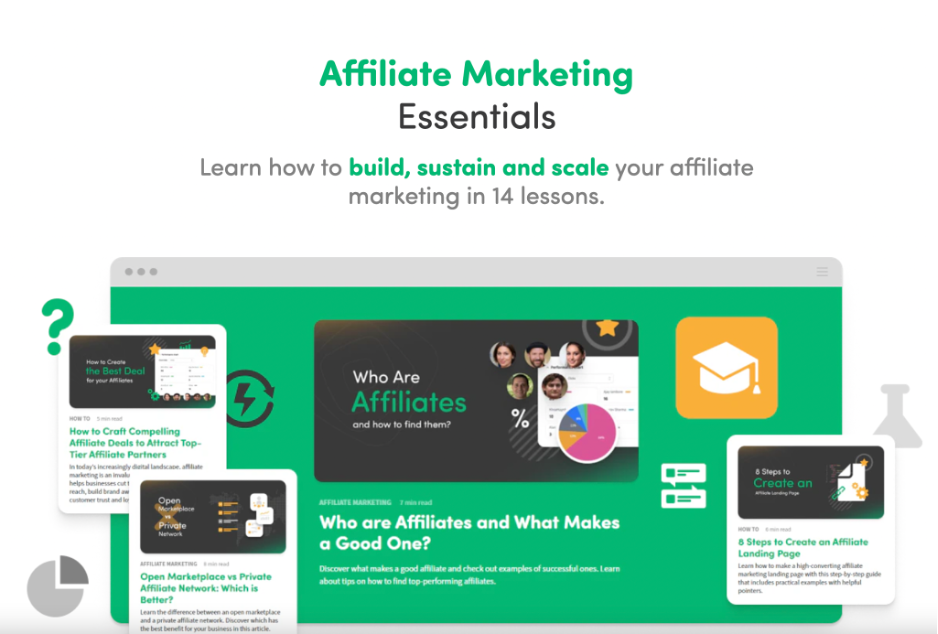
Your guides can be blog posts or videos that train your affiliates on how to use your product or service and which marketing methods have worked best for your top-performing affiliates. Here, a video editor enables affiliates to produce high-quality content, which can boost viewer engagement and conversions. You can also create tutorials using text to video AI to quickly turn written content into engaging visual training materials.
In addition, you can create an email newsletter just for your affiliates to share tips and tricks and even highlight top-earning affiliates and the marketing strategies they use.
Here’s a portion of an affiliate newsletter I like from one of my affiliate partners:
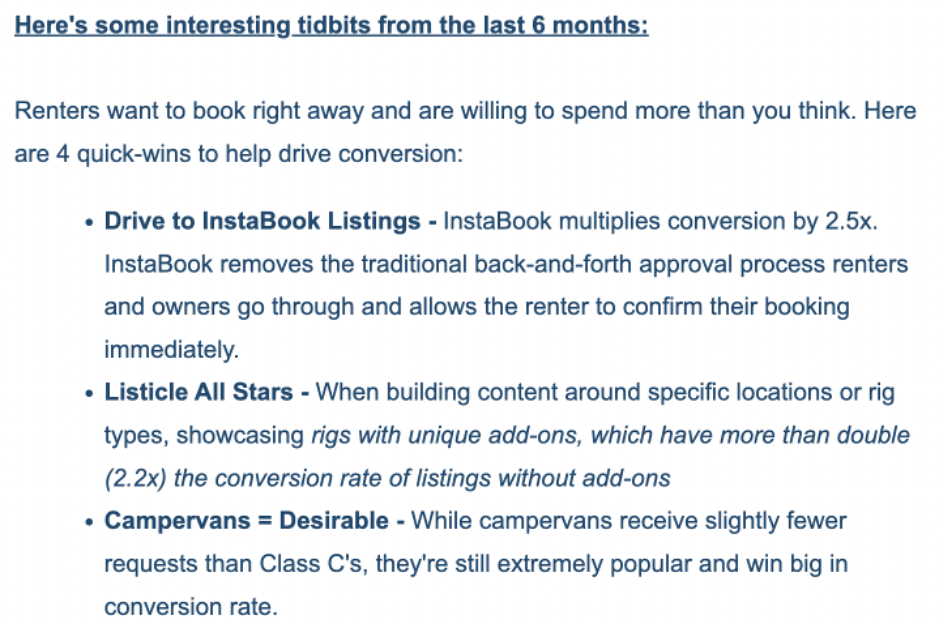
You can see they offer tips on how to get more conversions, which is a win-win.
But enough about the anatomy of an affiliate onboarding program — let’s talk about how to set yours up.
5 steps to set up your affiliate onboarding program
Below I go into five steps you can take to create an onboarding program from scratch:
- Create an onboarding email sequence
- Build a resource library
- Set up communication and support systems
- Offer incentive structures
- Evaluate and improve
Let’s dive in!
Step 1: Create an onboarding email sequence
Once an affiliate partner signs up for your affiliate marketing program, the first thing they should see is your welcome email. That is, an email congratulating them for joining that also tells them how to use your affiliate software and some tips to get started.
Pretty simple, right? But that’s where mediocre brands stop. They say “Welcome!” and leave the affiliates to do their own thing, rarely communicating again outside of automated emails whenever a sale is made.
Let’s take this a step further.
Your welcome email should not only welcome them to the program but also include:
- Video walkthroughs of the affiliate tracking software
- Videos or guides showcasing your product or service, explaining what makes it great and how your affiliates can best promote it
- Marketing materials to help with advertising, like banners, images, and promotional videos
- Your branding guidelines (colors, fonts, correct logo use, etc.)
This can be an overwhelming amount of information, which is why I recommend turning it into a drip campaign where you send several emails over a week or two rather than blasting them all at once.
Trackdesk also has a ton of native email functionalities you can use to automate this process.
Here’s a great example of a welcome email promoting a new Black Friday deal, with good formatting, product details, and an offer to help their affiliates write their sales copy for them:
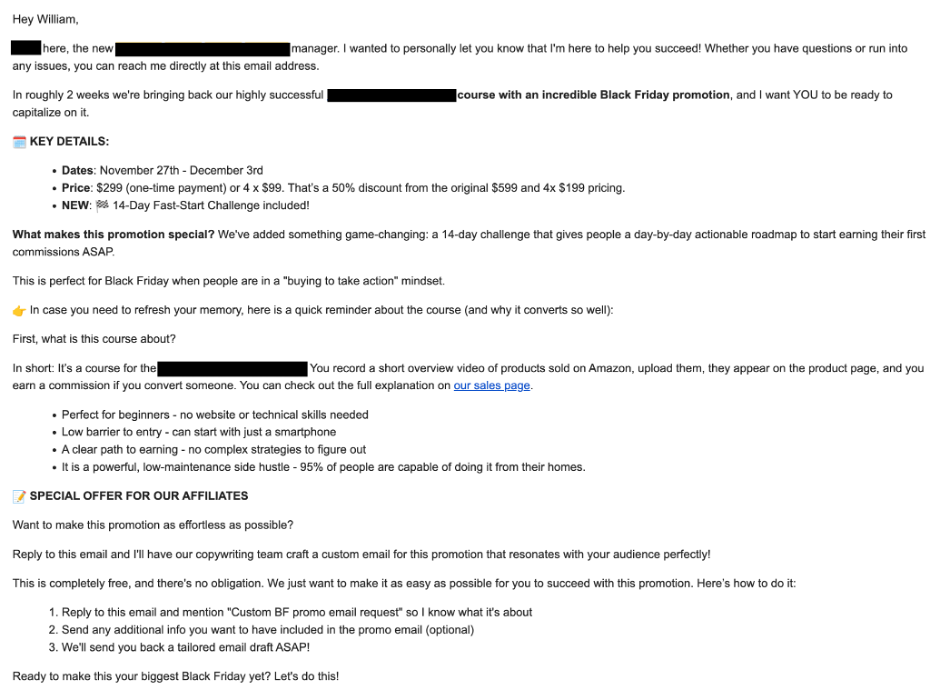
Step 2: Build a resource library
The best affiliate programs offer a resource library to train their affiliates.
This resource library can include things like:
Materials for getting started
- Affiliate handbook (program rules, commission structures, FAQs)
- Onboarding guide (step-by-step instructions to start promoting)
- Video tutorial for affiliate dashboard setup
- Instructions for using affiliate links
If you offer software, you can use Walnut.io to create custom interactive demos for your product tours and share them with your affiliates so they understand your product.
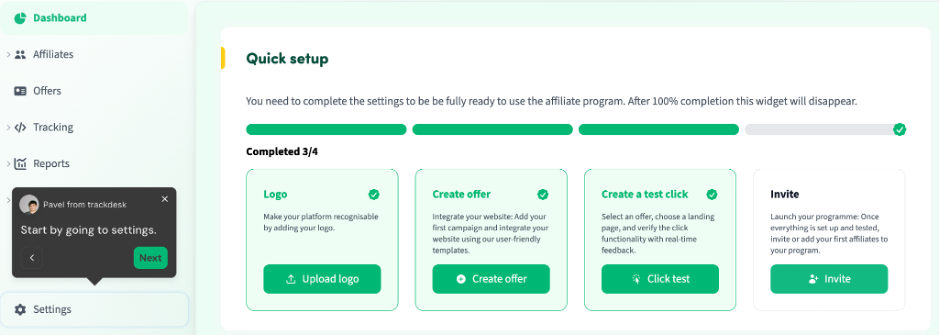
Product Information
- Detailed product/service descriptions
- Unique selling points (USPs)
- Product demo videos or walkthroughs
Marketing Materials
- Pre-approved ad copy (email, blogs, and social media)
- High-quality banners and graphics
- Sample email templates
- Social media post templates
- SEO and content creation tips
For example, SEMrush offers tons of different banners like these that you can easily insert into your blog content or on your website:

Compliance and Legal
- FTC disclosure guidelines
- Brand usage guidelines (logos, tone, etc.)
Training Materials
- Video tutorials for marketing best practices
- Recorded webinars or training sessions
Support
- Contact information for affiliate support
- Troubleshooting guides for common issues
You can add more, but these are a great start and get you ahead of 90% of your competitors. Most brands don’t put this kind of effort into their affiliate program, and it’s holding them back.
Step 3: Set up communication and support systems
I love when the brands I work with are great communicators. It helps foster a strong partnership.
Start by introducing your new affiliates to their main point of contact (a dedicated account manager if you have one). Send them a calendar link to schedule a one-on-one call with this contact or use tools like WhenAvailable meeting scheduler to decide on the best meeting time to streamline the process.
This initial meeting can be used to answer questions, provide clarity about the program, and discuss tailored strategies to help them achieve their goals. It’s also a good opportunity to build a stronger bond between your brand and your affiliates.
Next, let them know what support channels are available to them. Common options include email, a support ticketing system, or live chat.
For high-performing or VIP affiliates, you might consider offering direct access to their manager’s phone number or priority support.
I once worked so closely with one of my account managers that we were on a friendly texting and calling basis, and had meetings every other week about how we could make more money together.
He was always there to answer my questions, brainstorm ideas, and review my content when I asked him. Here’s an email he sent me with feedback on some copy I wrote to promote one of their new services:

This level of involvement obviously isn’t typical or required, but I’m just sharing it to let you know what’s possible. Regardless, be clear about response times and any specific protocols for reaching out so affiliates know what to expect.
And don’t worry about going overboard here. Great communication ≠ getting in touch all the time.
Just emphasize that your team is invested in their success and that you’re available for them if and when they need you. Proactive support fosters trust, keeps affiliates engaged, and ultimately drives better results for both parties. Win-win-win.
Step 4: Offer incentive structures
There’s a reason most salespeople work on commission — money and recognition can be huge motivators.
Create incentives to motivate affiliates to work harder and earn more sales, such as tiered commissions for reaching certain sales milestones, a leadership board to gamify your affiliate program, and competitions with rewards for being a top earner.
Check out our guide to setting profitable affiliate commission rates to learn more.
Step 5: Evaluate and improve
Continuous improvement is key to building a successful affiliate program.
Start by creating a feedback loop with your affiliates. Design a survey to gather their input. Keep it concise, with a mix of multiple-choice and open-ended questions to understand their experiences and challenges and get their suggestions. You never know — your affiliates might have some great ideas for you.
This article has a great sample survey you can copy and use, with questions like these:
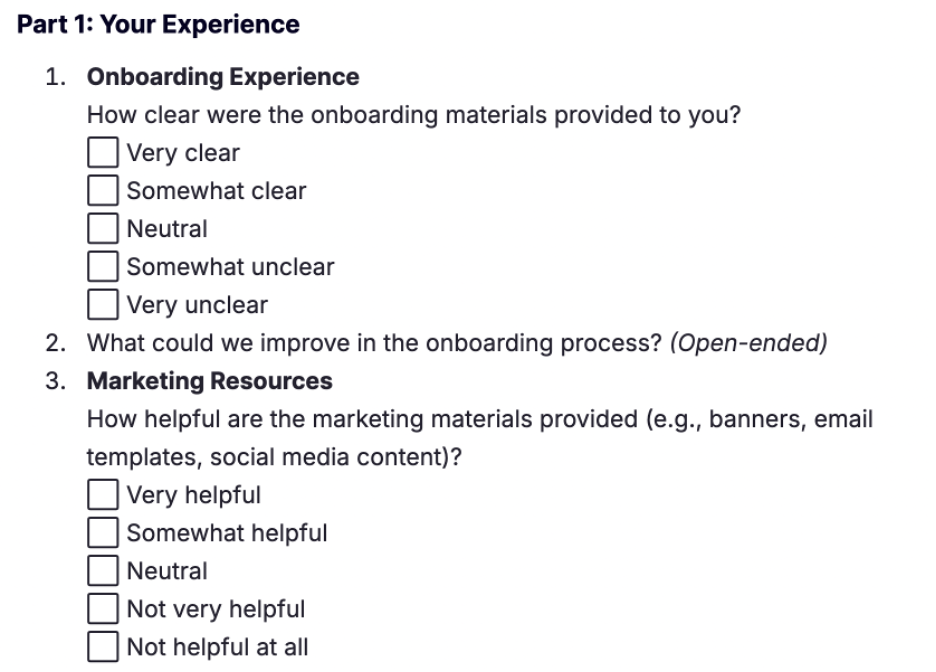
Ask questions about the clarity of onboarding materials, the effectiveness of your communication and support systems, and the quality of the marketing resources provided. Include a section where affiliates can share ideas for new tools or strategies that could help them perform better.
Review your survey responses regularly and implement when you learn. This not only makes your program better but also shows your affiliates that you value their input and are committed to their success.
And that’s all there is to it!
Onboard affiliates easier with Trackdesk
Onboarding new affiliates can be a complicated process. You need to invest a lot of time and energy into creating training materials and it can be costly to hire an affiliate account manager.
But Trackdesk makes things easier.
Not only do we have an intuitive, easy-to-use interface — we make it easy to manage your affiliates and provide training resources to help you easily onboard your affiliates into the software and get them earning commissions (and making you sales) right away.
Sign up for a free Trackdesk account today and start onboarding your affiliates right away.

Bill is a serial entrepreneur, business coach, affiliate marketer, and copywriter with a passion for creating content. When he's not busy beating the Google algorithm, you can find him hiking with his dog, at the gym, or singing karaoke.
